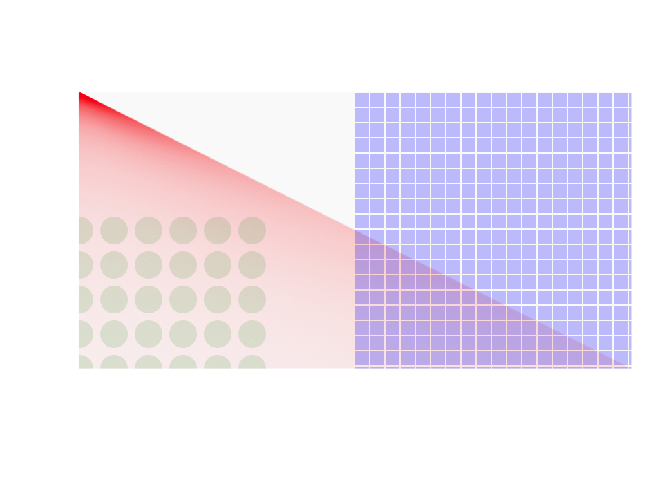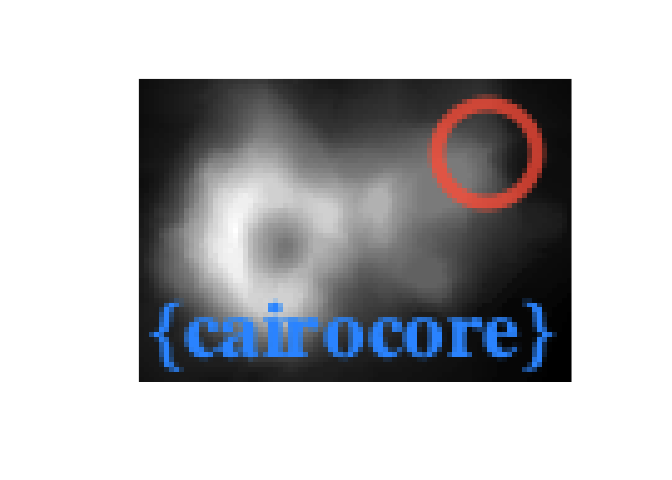cairocore
cairocore provides a canvas and tools for fast 2d drawing operations.
It provides a low-level wrapper around the cariographics 2D graphics library (written in C) which provides drawing operations and related functions, with consistent output on multiple platforms and output media (e.g. SVG, PDF, PNG etc).
This package is not a graphics device - you can’t plot to it. Instead it provides a canvas for directly drawing shapes and text.
View the online documentation here




Key Features
- Very fast line and shape drawing
- Convert canvas surface to/from R arrays - this means you can draw on an array from within R
- Alpha-blending and anti-aliasing
- Direct control of what pixels get put on a canvas i.e. not having to pass through an intermediate plotting step (e.g. ggplot) or graphics device (e.g. png())
Package Philosophy
cairocore is a one-to-one mapping from R functions to C functions in the cariographics
C library.
This package will remain very “C-like”, but other packages are
welcome to wrap this cairocore to enable more idiomatic R programming styles.
One such wrapper is cairobasic which offers a subset of the possible drawing operations with a friendlier interface.
Installation Pre-requisite: Cairographics C library + headers
CairoGraphicslibrary installed- See CairoGraphics downloads page for more information on how this might work on your platform.
Install CairoGraphics on Mac OSX
Install CairoGraphics on Linux
- Debian/Ubuntu -
sudo apt-get install libcairo2-dev - Fedora -
sudo yum install cairo-devel - openSUSE -
zypper install cairo-devel
Install CairoGraphics on Windows
I haven’t been able to test any of the windows techniques - if you are a windows user, please let me know what worked for you!
- CairoGraphics downloads page for more information
- Try the following:
Installation
You can install from GitHub with:
# install.package('remotes')
remotes::install_github('coolbutuseless/cairocore')Documentation + Tutorials
cairocore behaves almost identically to the CairoGraphics C library and in
many cases examples from the internet (which are all in C code) may be lightly modified and used as R code.
The documentation for cairocore is mostly a direct translation of the
CairoGraphics documentation and
has been extracted from the C source files.
View the online documentation here
A great tutorial on using CairoGraphics in C is from zetcode.
Vignettes
I’ve tried to highlight a few interesting features of CairoGrapihcs in the vignettes, but the library is huge and I can’t cover all of it here.
Hopefully there are enough code examples to get you started!
- Creating patterns
- Drawing on R arrays create a drawing canvas from an R array and draw on it
- Drawing simple shapes
- Image output formats
- Using Transforms by default CairoGraphics considers the origin to be the top left of the page. This vignette sets the transformation matrix on a surface such that the bottom left corner is considered the origin.
- Vectorised functions there are some custom functions for drawing multitudes of the same type of element. There is a speed advantage in looping over data within C rather than within R.
- Technical - enums in C
- Technical - pointers in C
- Technical - structs in C
Example - Using cairocore as a drawing canvas

Click to show/hide code
library(cairocore)
#~~~~~~~~~~~~~~~~~~~~~~~~~~~~~~~~~~~~~~~~~~~~~~~~~~~~~~~~~~~~~~~~~~~~~~~~~~~~~
# Create a surface to draw on.
#~~~~~~~~~~~~~~~~~~~~~~~~~~~~~~~~~~~~~~~~~~~~~~~~~~~~~~~~~~~~~~~~~~~~~~~~~~~~~
width <- 800
height <- 400
surface <- cairo_image_surface_create(
format = cairo_format_t$CAIRO_FORMAT_ARGB32,
width = width,
height = height
)
#~~~~~~~~~~~~~~~~~~~~~~~~~~~~~~~~~~~~~~~~~~~~~~~~~~~~~~~~~~~~~~~~~~~~~~~~~~~~~
# Every surface must have a context in order to operate on it.
# For faster operation, antialiasing can be switched off
#~~~~~~~~~~~~~~~~~~~~~~~~~~~~~~~~~~~~~~~~~~~~~~~~~~~~~~~~~~~~~~~~~~~~~~~~~~~~~
cr <- cairo_create(surface)
#~~~~~~~~~~~~~~~~~~~~~~~~~~~~~~~~~~~~~~~~~~~~~~~~~~~~~~~~~~~~~~~~~~~~~~~~~~~~~
# Clear the surface to a light grey
#~~~~~~~~~~~~~~~~~~~~~~~~~~~~~~~~~~~~~~~~~~~~~~~~~~~~~~~~~~~~~~~~~~~~~~~~~~~~~
cairo_set_source_rgb(cr, 0.98, 0.98, 0.98)
cairo_paint(cr)
#~~~~~~~~~~~~~~~~~~~~~~~~~~~~~~~~~~~~~~~~~~~~~~~~~~~~~~~~~~~~~~~~~~~~~~~~~~~~~
# Draw some red lines
#~~~~~~~~~~~~~~~~~~~~~~~~~~~~~~~~~~~~~~~~~~~~~~~~~~~~~~~~~~~~~~~~~~~~~~~~~~~~~
cairo_set_source_rgba(cr, 1, 0, 0, 0.02)
for (i in seq(width)) {
cairo_move_to(cr, 0, 0)
cairo_line_to(cr, i, height)
cairo_stroke(cr)
}
#~~~~~~~~~~~~~~~~~~~~~~~~~~~~~~~~~~~~~~~~~~~~~~~~~~~~~~~~~~~~~~~~~~~~~~~~~~~~~
# Draw some rectangles
#~~~~~~~~~~~~~~~~~~~~~~~~~~~~~~~~~~~~~~~~~~~~~~~~~~~~~~~~~~~~~~~~~~~~~~~~~~~~~
cairo_set_line_width(cr, 0.5)
cairo_set_source_rgba(cr, 0, 0, 1, 0.2)
for (j in seq(1, height, 22)) {
for (i in seq(width/2, width, 22)) {
cairo_rectangle(cr, i, j, 20, 20)
cairo_fill(cr)
}
}
#~~~~~~~~~~~~~~~~~~~~~~~~~~~~~~~~~~~~~~~~~~~~~~~~~~~~~~~~~~~~~~~~~~~~~~~~~~~~~
# Draw green circles
#~~~~~~~~~~~~~~~~~~~~~~~~~~~~~~~~~~~~~~~~~~~~~~~~~~~~~~~~~~~~~~~~~~~~~~~~~~~~~
for (x in seq(1, width/3, 50)) {
for (y in seq(height/2, height, 50)) {
cairo_set_source_rgba(cr, 0, 0.5, 0, 0.1)
cairo_arc(cr, x, y, radius = 20, 0, 2*pi)
cairo_fill(cr)
}
}
#~~~~~~~~~~~~~~~~~~~~~~~~~~~~~~~~~~~~~~~~~~~~~~~~~~~~~~~~~~~~~~~~~~~~~~~~~~~~~
# Get the image surface as a raster
#~~~~~~~~~~~~~~~~~~~~~~~~~~~~~~~~~~~~~~~~~~~~~~~~~~~~~~~~~~~~~~~~~~~~~~~~~~~~~
raster_out <- cairo_image_surface_get_raster(surface, nchannel = 3)
plot(raster_out, interpolate = FALSE)
#~~~~~~~~~~~~~~~~~~~~~~~~~~~~~~~~~~~~~~~~~~~~~~~~~~~~~~~~~~~~~~~~~~~~~~~~~~~~~
# Save the surface as a PNG
#~~~~~~~~~~~~~~~~~~~~~~~~~~~~~~~~~~~~~~~~~~~~~~~~~~~~~~~~~~~~~~~~~~~~~~~~~~~~~
cairo_surface_write_to_png(surface, tempfile(fileext = ".png"))
[1] 0Example - drawing 10,000 alpha blended lines

Click to show/hide code
library(cairocore)
#~~~~~~~~~~~~~~~~~~~~~~~~~~~~~~~~~~~~~~~~~~~~~~~~~~~~~~~~~~~~~~~~~~~~~~~~~~~~~
# Calculate the end coordinates of a lot of line segments
#~~~~~~~~~~~~~~~~~~~~~~~~~~~~~~~~~~~~~~~~~~~~~~~~~~~~~~~~~~~~~~~~~~~~~~~~~~~~~
width <- 1000
height <- 500
N <- 10000
t <- seq(0, 2*pi, length.out = N)
x1 <- width * sin(t)
x2 <- width * sin(2 * t + pi/2)
y1 <- height * cos(t)
y2 <- height * cos(4*t + pi/2)
#~~~~~~~~~~~~~~~~~~~~~~~~~~~~~~~~~~~~~~~~~~~~~~~~~~~~~~~~~~~~~~~~~~~~~~~~~~~~~
# Create a surface to draw on.
#~~~~~~~~~~~~~~~~~~~~~~~~~~~~~~~~~~~~~~~~~~~~~~~~~~~~~~~~~~~~~~~~~~~~~~~~~~~~~
surface <- cairo_image_surface_create(
format = cairo_format_t$CAIRO_FORMAT_ARGB32,
width = width,
height = height
)
#~~~~~~~~~~~~~~~~~~~~~~~~~~~~~~~~~~~~~~~~~~~~~~~~~~~~~~~~~~~~~~~~~~~~~~~~~~~~~
# Every surface must have a context in order to operate on it.
# For faster operation, antialiasing can be switched off
#~~~~~~~~~~~~~~~~~~~~~~~~~~~~~~~~~~~~~~~~~~~~~~~~~~~~~~~~~~~~~~~~~~~~~~~~~~~~~
cr <- cairo_create(surface)
# cairo_set_antialias(cr, cairo_antialias_t$CAIRO_ANTIALIAS_NONE)
#~~~~~~~~~~~~~~~~~~~~~~~~~~~~~~~~~~~~~~~~~~~~~~~~~~~~~~~~~~~~~~~~~~~~~~~~~~~~~
# Clear the surface to a light grey
#~~~~~~~~~~~~~~~~~~~~~~~~~~~~~~~~~~~~~~~~~~~~~~~~~~~~~~~~~~~~~~~~~~~~~~~~~~~~~
cairo_set_source_rgb(cr, 0.98, 0.98, 0.98)
cairo_paint(cr)
#~~~~~~~~~~~~~~~~~~~~~~~~~~~~~~~~~~~~~~~~~~~~~~~~~~~~~~~~~~~~~~~~~~~~~~~~~~~~~
# Set the drawing colour for subsequent operations
#~~~~~~~~~~~~~~~~~~~~~~~~~~~~~~~~~~~~~~~~~~~~~~~~~~~~~~~~~~~~~~~~~~~~~~~~~~~~~
cairo_set_source_rgba(cr, 0.2, 0.3, 1, 0.01)
#~~~~~~~~~~~~~~~~~~~~~~~~~~~~~~~~~~~~~~~~~~~~~~~~~~~~~~~~~~~~~~~~~~~~~~~~~~~~~
# Draw each line -
# this seems laborious but it is idiomatic C/cairo programming style
#~~~~~~~~~~~~~~~~~~~~~~~~~~~~~~~~~~~~~~~~~~~~~~~~~~~~~~~~~~~~~~~~~~~~~~~~~~~~~
for (i in seq(N)) {
cairo_move_to(cr, x1[i], y1[i])
cairo_line_to(cr, x2[i], y2[i])
cairo_stroke(cr)
}
#~~~~~~~~~~~~~~~~~~~~~~~~~~~~~~~~~~~~~~~~~~~~~~~~~~~~~~~~~~~~~~~~~~~~~~~~~~~~~
# Write some text on the cairo surface
# `cairo_font_slant_t` and `cairo_font_weight_t` are enums in C which have
# been encoded as lists in R.
#~~~~~~~~~~~~~~~~~~~~~~~~~~~~~~~~~~~~~~~~~~~~~~~~~~~~~~~~~~~~~~~~~~~~~~~~~~~~~
cairo_select_font_face (
cr,
family = "sans",
slant = cairo_font_slant_t$CAIRO_FONT_SLANT_NORMAL,
weight = cairo_font_weight_t$CAIRO_FONT_WEIGHT_BOLD
)
cairo_set_font_size(cr, 57.0)
cairo_set_source_rgba(cr, 0, 0, 0, 0.3)
cairo_move_to (cr, 5.0, 60.0)
cairo_show_text (cr, "{cairocore}")
#~~~~~~~~~~~~~~~~~~~~~~~~~~~~~~~~~~~~~~~~~~~~~~~~~~~~~~~~~~~~~~~~~~~~~~~~~~~~~
# Get the image surface as a raster
#~~~~~~~~~~~~~~~~~~~~~~~~~~~~~~~~~~~~~~~~~~~~~~~~~~~~~~~~~~~~~~~~~~~~~~~~~~~~~
raster_out <- cairo_image_surface_get_raster(surface, nchannel = 3)
plot(raster_out, interpolate = FALSE)
Example - taking an array in R, drawing on it, returning it to R

Click to show/hide code
library(cairocore)
#~~~~~~~~~~~~~~~~~~~~~~~~~~~~~~~~~~~~~~~~~~~~~~~~~~~~~~~~~~~~~~~~~~~~~~~~~~~~~
# Let's grab the volcano
#~~~~~~~~~~~~~~~~~~~~~~~~~~~~~~~~~~~~~~~~~~~~~~~~~~~~~~~~~~~~~~~~~~~~~~~~~~~~~
arr <- (t(volcano) - min(volcano))/(max(volcano) - min(volcano))
plot(as.raster(arr), interpolate = FALSE)
#~~~~~~~~~~~~~~~~~~~~~~~~~~~~~~~~~~~~~~~~~~~~~~~~~~~~~~~~~~~~~~~~~~~~~~~~~~~~~
# Initialise a surface from the array
#~~~~~~~~~~~~~~~~~~~~~~~~~~~~~~~~~~~~~~~~~~~~~~~~~~~~~~~~~~~~~~~~~~~~~~~~~~~~~
surface <- cairo_image_surface_create_from_array(arr)
cr <- cairo_create(surface)
#~~~~~~~~~~~~~~~~~~~~~~~~~~~~~~~~~~~~~~~~~~~~~~~~~~~~~~~~~~~~~~~~~~~~~~~~~~~~~
# Draw a circle on the cairo surface
#~~~~~~~~~~~~~~~~~~~~~~~~~~~~~~~~~~~~~~~~~~~~~~~~~~~~~~~~~~~~~~~~~~~~~~~~~~~~~
cairo_arc(cr, 70, 15, 10, 0, 2*pi)
cairo_set_line_width(cr, 3);
cairo_set_source_rgba(cr, 255/255, 99/255, 71/255, 0.8)
cairo_stroke(cr)
#~~~~~~~~~~~~~~~~~~~~~~~~~~~~~~~~~~~~~~~~~~~~~~~~~~~~~~~~~~~~~~~~~~~~~~~~~~~~~
# Write some text on the cairo surface
#~~~~~~~~~~~~~~~~~~~~~~~~~~~~~~~~~~~~~~~~~~~~~~~~~~~~~~~~~~~~~~~~~~~~~~~~~~~~~
cairo_select_font_face (cr, "serif", cairo_font_slant_t$CAIRO_FONT_SLANT_NORMAL, cairo_font_weight_t$CAIRO_FONT_WEIGHT_BOLD)
cairo_set_font_size (cr, 17.0)
cairo_set_source_rgb (cr, 0.2, 0.6, 1.0)
cairo_move_to (cr, 2.0, 56.0)
cairo_show_text (cr, "{cairocore}")
#~~~~~~~~~~~~~~~~~~~~~~~~~~~~~~~~~~~~~~~~~~~~~~~~~~~~~~~~~~~~~~~~~~~~~~~~~~~~~
# Fetch the drawing surface as an array
#~~~~~~~~~~~~~~~~~~~~~~~~~~~~~~~~~~~~~~~~~~~~~~~~~~~~~~~~~~~~~~~~~~~~~~~~~~~~~
array_out <- cairo_image_surface_get_array(surface=surface)
plot(as.raster(array_out), interpolate = FALSE)
Acknowledgements
- R Core for developing and maintaining R
- CRAN maintainers, for patiently shepherding packages onto CRAN and maintaining the repository
